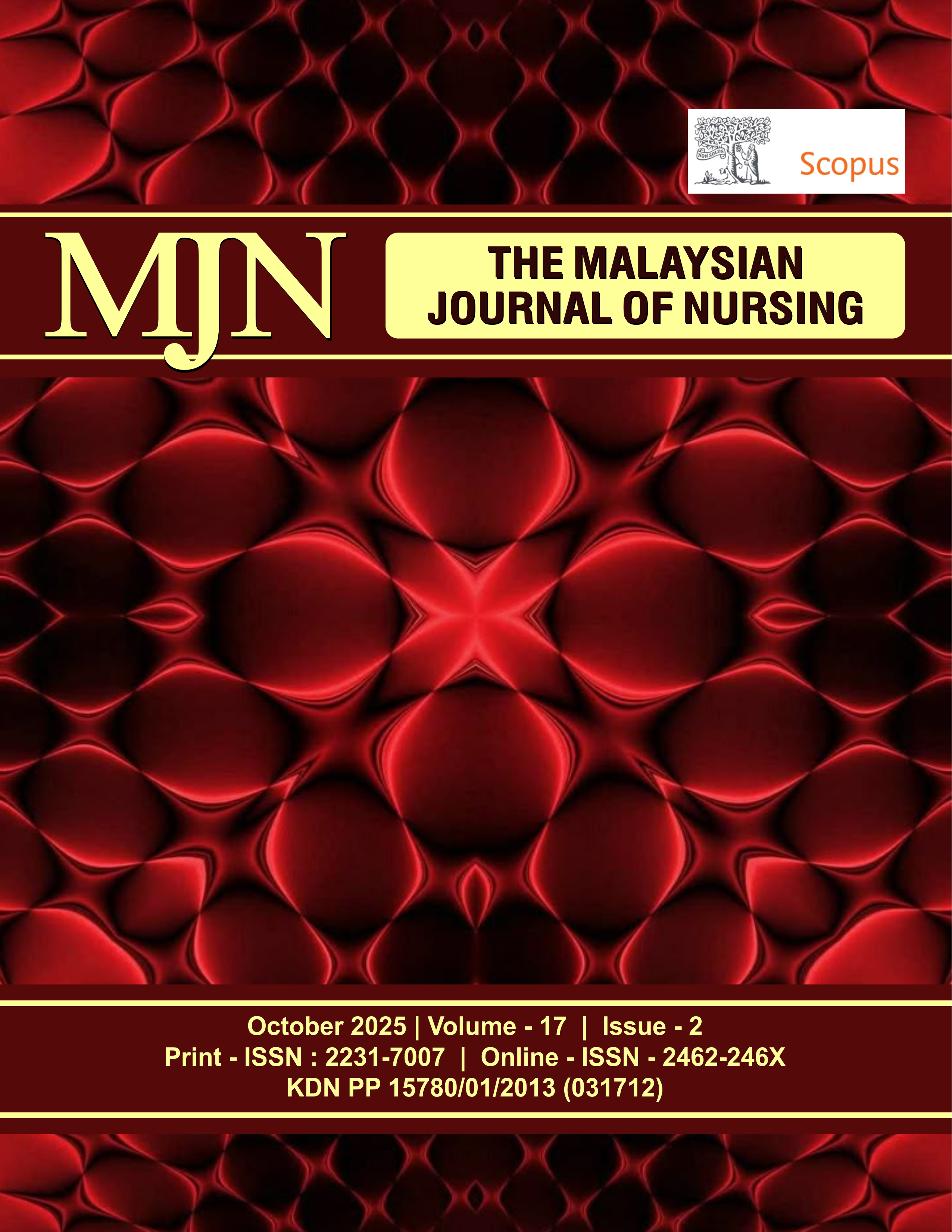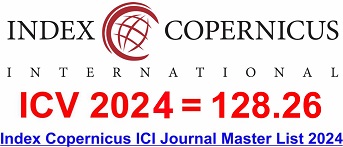Effect of Online Learning on Nursing Students Satisfaction, Confidence and Skill Performance: A Systematic Review
DOI:
https://doi.org/10.31674/mjn.2025.v17i02.025Abstract
Background: The COVID-19 pandemic accelerated the transition from traditional face-to-face nursing education to online platforms, raising questions about its effect on student outcomes. Objective: This systematic review examined the effect of online learning on nursing students’ satisfaction, confidence, and skill performance. Methods: Following PRISMA 2020 guidelines, four databases (ScienceDirect, Cochrane Library, Karger and PubMed) were searched for studies published between January 2020 and December 2024. Eligible studies included quasi-experimental or randomised controlled trial designs with nursing student participants. Two reviewers independently screened studies and assessed risk of bias using JBI tools. Results: Nine studies met inclusion criteria (seven quasi-experimental, two randomised controlled trials). Findings on satisfaction were mixed: game-based and Moodle-based learning improved satisfaction, while traditional hands-on methods remained preferred in some contexts. Confidence was enhanced through interactive approaches such as augmented and virtual reality, although traditional training remained more effective for hands-on skills. Skill performance improved with web-based interactive methods, but traditional demonstrations were more effective for procedural skills like IV catheter placement. Conclusions: Online learning can improve satisfaction, confidence and knowledge, particularly when interactive technologies are integrated. However, face-to-face training remains essential for psychomotor and clinical skill development. The evidence supports hybrid models that balance digital engagement with hands-on practice. Future research should examine long-term outcomes, cost-effectiveness, and culturally adapted digital strategies in nursing education.
Keywords:
Online Learning, Nursing Education, Satisfaction, Confidence, Skill PerformanceDownloads
References
Abdelaliem, S. M. F., Alsleem, D. K., Aladdad, S. K., Alqahtani, A. S., Alenazi, R. K., Alotaibi, M. G., Oqailan, H. K., & Almarshad, L. B. (2025). The relationship between practical skills confidence and readiness for transition to practice among nursing internship students: Exploring the mediating role of preceptorship. Nurse Education Today, 147, 106587. https://doi.org/10.1016/j.nedt.2025.106587
Alsadi, M., Oweidat, I., Khrais, H., Tubaishat, A., & Nashwan, A. J. (2023). Satisfaction and self-confidence among nursing students with simulation learning during COVID-19. BMC Nursing, 22(1), 1–8. https://doi.org/10.1186/s12912-023-01489-1
Avci, M., & Kilic, S. P. (2024). The effect of augmented reality applications on intravenous catheter placement skill in nursing students: A randomized controlled study. Clinical Simulation in Nursing, 90, 101524. https://doi.org/10.1016/j.ecns.2024.101524
Barker, T. H., Habibi, N., Aromataris, E., Stone, J. C., Leonardi-Bee, J., Sears, K., Hasanoff, S., Klugar, M., Tufanaru, C., Moola, S., & Munn, Z. (2024). The revised JBI critical appraisal tool for the assessment of risk of bias for quasi-experimental studies. JBI Evidence Synthesis, 22(3), 378–388. https://doi.org/10.11124/JBIES-23-00268
Berga, K. A., Vadnais, E., Nelson, J., Johnston, S., Buro, K., Hu, R., & Olaiya, B. (2021). Blended learning versus face-to-face learning in an undergraduate nursing health assessment course: A quasi-experimental study. Nurse Education Today, 96, 104622. https://doi.org/10.1016/j.nedt.2020.104622
Busolo, D., Forbes, N., Taylor, P., Gordon, R., Hickey, J., Keough, A., & Duffney, A. (2025). Innovating clinical nursing education using virtual technology to combat the effects of COVID-19: A qualitative study. Nurse Education Today, 144(October 2024). https://doi.org/10.1016/j.nedt.2024.106478
Chen, C. J., Tsai, H. J., Lee, M. Y., Chen, Y. C., & Huang, S. M. (2023). Effects of a Moodle-based E-learning environment on E-collaborative learning, perceived satisfaction, and study achievement among nursing students: A cross-sectional study. Nurse Education Today, 130, 105921. https://doi.org/10.1016/j.nedt.2023.105921
Dolorfino, E., Dusaran, J. R., Esguerra, R. R. L., Espiritu, Q., Kimberly, A. F., Gavino, J., Alyssa, N. L., Mallillin, M., Malubay, S., Mangino, E., & Ruelos, R. G. (2025). Clinical confidence in virtual and on-ground related learning experiences among nursing students at Adamson University. European Journal of Public Health Studies, 8(1), 103–117. https://doi.org/10.46827/ejphs.v8i1.207
Du, L., Zhao, L., Xu, T., Wang, Y., Zu, W., Huang, X., Nie, W., & Wang, L. (2022). Blended learning vs traditional teaching: The potential of a novel teaching strategy in nursing education – a systematic review and meta-analysis. Nurse Education in Practice, 63, 103354. https://doi.org/10.1016/j.nepr.2022.103354
El-hamied, A. A., Ahmed, T. R., El-Sherbeny, E. M., & Mohesen, M. N. (2024). Awareness of nursing students regarding online learning and its effects on community health at Beni-Suef University. Journal of Health Care Research, 2(1), 235–249. https://journals.ekb.eg/article_410507_6fa77ef299e28c94e889572148549369.pdf
Foronda, C. L., Fernandez-Burgos, M., Nadeau, C., Kelley, C. N., & Henry, M. N. (2020). Virtual simulation in nursing education: A systematic review spanning 1996 to 2018. Simulation in Healthcare, 15(1), 46–54. https://doi.org/10.1097/sih.0000000000000411
Gause, G., Mokgaola, I. O., & Rakhudu, M. A. (2022). Technology usage for teaching and learning in nursing education: An integrative review. Curationis, 45(1), 1–9. https://doi.org/10.4102/curationis.v45i1.2261
Harjanto, T., Gautama, M. S. N., & Sumunar, D. (2023). Effect of online case-based learning on nursing students’ self-confidence amid COVID-19 pandemic. Bali Medical Journal, 12(1), 519–523. https://doi.org/10.15562/bmj.v12i1.3702
Hudder, K., Buck-McFadyen, E., Regts, M., & Bushuk, K. (2021). A quasi-experimental study comparing virtual simulation to lab-based learning of newborn assessment among nursing students. Clinical Simulation in Nursing, 55, 59–66. https://doi.org/10.1016/j.ecns.2021.04.002
Hung, C. C., Kao, H. F. S., Liu, H. C., Liang, H. F., Chu, T. P., & Lee, B. O. (2021). Effects of simulation-based learning on nursing students’ perceived competence, self-efficacy, and learning satisfaction: A repeat measurement method. Nurse Education Today, 97, 104725. https://doi.org/10.1016/j.nedt.2020.104725
Jallad, S. T. (2025). Effectiveness of Simulation-Based Education on Educational Practices of Communication Skills, Satisfaction, and Self-Confidence Among Undergraduate Nursing Students. Creative Nursing, 31(2), 135–143. https://doi.org/10.1177/10784535241301115
Khozaei, S. A., Zare, N. V., Moneghi, H. K., Sadeghi, T., & Taraghdar, M. M. (2022). Effects of quantum-learning and conventional teaching methods on learning achievement, motivation to learn, and retention among nursing students during critical care nursing education. Smart Learning Environments, 9(1), 18. https://doi.org/10.1186/s40561-022-00198-7
Kumar, A., Sarkar, M., Davis, E., Morphet, J., Maloney, S., Ilic, D., & Palermo, C. (2021). Impact of the COVID-19 pandemic on teaching and learning in health professional education: A mixed methods study protocol. BMC Medical Education, 21(1), 439. https://doi.org/10.1186/s12909-021-02871-w
Munn, Z., Stone, J. C., Aromataris, E., Klugar, M., Sears, K., Leonardi-Bee, J., & Barker, T. H. (2022). Assessing the risk of bias of quantitative analytical studies: introducing the vision for critical appraisal within JBI systematic reviews. JBI Evidence Synthesis, 21(3), 467–471. https://doi.org/10.11124/JBIES-22-00224
Natarajan, J., Joseph, M. A., Al Shibli, Z. S., Al Hajji, S. S., Al Hanawi, D. K., Al Kharusi, A. N., & Al Maqbali, I. M. (2022). Effectiveness of an interactive educational video on knowledge, skill and satisfaction of nursing students. Sultan Qaboos University Medical Journal, 22(4), 546–553. https://doi.org/10.18295/squmj.2.2022.013
Nowell, L., Dhingra, S., Carless-Kane, S., McGuinness, C., Paolucci, A., Jacobsen, M., Lorenzetti, D. L., Lorenzetti, L., & Paolucci, E. D. (2022). A systematic review of online education initiatives to develop students remote caring skills and practices. Medical Education Online, 27(1). https://doi.org/10.1080/10872981.2022.2088049
O’Doherty, D., Dromey, M., Lougheed, J., Hannigan, A., Last, J., & McGrath, D. (2018). Barriers and solutions to online learning in medical education—An integrative review. BMC Medical Education, 18, 130. https://doi.org/10.1186/s12909-018-1240-0
Öz, G. Ö., & Ordu, Y. (2021). The effects of web-based education and Kahoot usage in evaluation of the knowledge and skills regarding intramuscular injection among nursing students. Nurse Education Today, 103, 104910. https://doi.org/10.1016/j.nedt.2021.104910
Page, M. J., McKenzie, J. E., Bossuyt, P. M., Boutron, I., Hoffmann, T. C., Mulrow, C. D., Shamseer, L., Tetzlaff, J. M., Akl, E. A., Brennan, S. E., Chou, R., Glanville, J., Grimshaw, J. M., Hróbjartsson, A., Lalu, M. M., Li, T., Loder, E. W., Mayo-Wilson, E., McDonald, S., … Moher, D. (2021). The PRISMA 2020 statement: An updated guideline for reporting systematic reviews. BMJ, 372, n71. https://doi.org/10.1136/bmj.n71
Park, S., & Yoon, H. G. (2023). Effect of virtual-reality simulation of indwelling catheterization on nursing students’ skills, confidence, and satisfaction. Clinical Simulation in Nursing, 80, 46–54. https://doi.org/10.1016/j.ecns.2023.05.001
Saied, E. A. R., Araby, O. A. E. A., & El Desoky, N. A. I. (2025). Effect of virtual reality as a training strategy on obstetric nursing students’ skills, self confidence and satisfaction regarding cardiopulmonary resuscitation during pregnancy. International Egyptian Journal of Nursing Sciences and Research, 6(1). https://doi.org/10.21608/EJNSR.2025.352559.1425
Sarvan, S., & Efe, E. (2022). The effect of neonatal resuscitation training based on a serious game simulation method on nursing students’ knowledge, skills, satisfaction and self-confidence levels: A randomized controlled trial. Nurse Education Today, 111, 105298. https://doi.org/10.1016/j.nedt.2022.105298
Shen, H., Hallensleben, C., Shi, H., Van Der Kleij, R., Dai, H., & Chavannes, N. (2024). International collaboration in an online digital health education for undergraduate nursing students in China: Results and recommendations for course development from World eHealth Living Lab. Clinical eHealth. https://doi.org/10.1016/j.ceh.2024.11.001
Steenkamp, I., & Chipps, J. (2024). Blended learning: Assessing nursing students ‘perspectives. Curationis, 47(1). https://doi.org/10.4102/curationis.v47i1.2579
Swift, L., Henderson, A., & Wu, C. J. (2022). Self-confidence in clinical skill: A descriptive study of the perspective of first-year nursing students. Nurse Education in Practice, 58, 103270. https://doi.org/10.1016/j.nepr.2021.103270
Tang, K. S., Cheng, D. L., Mi, E., & Greenberg, P. B. (2019). Augmented reality in medical education: a systematic review. Canadian Medical Education Journal. https://doi.org/10.36834/cmej.61705
Trifu, A., Smîdu, E., Badea, D. O., Bulboacă, E., & Haralambie, V. (2022). Applying the PRISMA method for obtaining systematic reviews of occupational safety issues in literature search. MATEC Web of Conferences, 354, 00052. https://doi.org/10.1051/matecconf/202235400052
Uslu-Sahan, F., Ozdemir, L., Karadas, M. M., Yildirim, S., & Odabasi, O. (2025). Virtual reality and standardized patient simulation programs in chemotherapy education for breast cancer: A comparative analysis of nursing students’ knowledge, cognitive load, satisfaction and confidence. Nurse Education in Practice, 83, 104286. https://doi.org/10.1016/j.nepr.2025.104286
Wang, R., & Raman, A. (2025). Systematic literature review on the effects of blended learning in nursing education. Nurse Education in Practice, 82, 104238. https://doi.org/10.1016/j.nepr.2024.104238
Wu, C. J., Chen, S. M., & Ramis, M. A. (2025). Educational challenges for post-graduate nursing students throughout the COVID-19 Pandemic: A scoping review. Nursing and Health Sciences, 27(1), 1–9, e70032. https://doi.org/10.1111/nhs.70032
Published
How to Cite
Issue
Section
License
Copyright (c) 2025 The Malaysian Journal of Nursing (MJN)

This work is licensed under a Creative Commons Attribution-NonCommercial-NoDerivatives 4.0 International License.



































